A Mule Deer and a Whitetail. Can you tell which is which?

A Mule Deer and a Whitetail. Can you tell which is which?

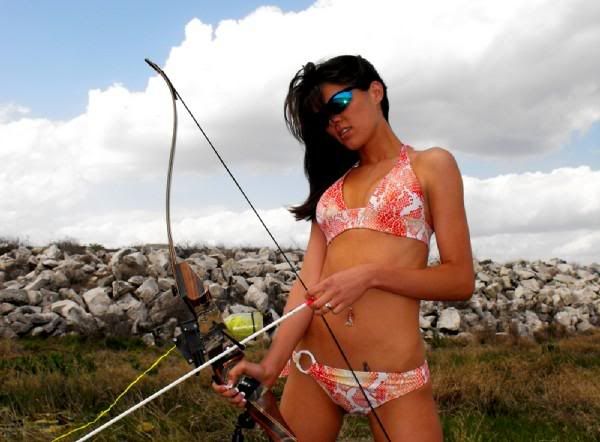
Mule Deer Archery Season is just around the corner for most western states. Here are a few helpful reminders for you archery nuts:
———————————-
Get your supplies HERE
——————————
- Over 55,000 mule deer roam BLM public lands in the Rock Springs District.
- Mule deer inhabit every major vegetation type in western North America and every climate zone except arctic and tropics. Mule deer in high elevation ranges may migrate up to 50 miles between summer and winter range. Snow depth and forage availability is considered to be the dominant factor in population control by many.
- Mule deer occupy a wide range of habitats. Food, cover, arid water requirements change with the seasons. Mule deer often must compete with livestock grazing practices and other human-caused disturbances. Proper land management can benefit deer.
- Mule deer gain weight during spring, summer, and fall. Deer must be in excellent condition in the fall of each year to survive the harsh winter weather.
- Deer eat a wide variety of foods. The major foods eaten by mule deer include sagebrush, serviceberry, snowberry, rabbitbrush, aspen, bitterbrush, juniper, willow, mountain mahogany, grasses, and forbs. In winter, more shrubs are eaten than dead forbs and grasses. Shrubs are alive and provide more protein and carbohydrates. Mule deer in North America have adapted to these long periods of nutritional stress caused by winter. Protection from human disturbance helps mule deer survive winter stress periods.
- Males gain and lose weight more rapidly than females.
- Both sexes essentially starve a little each day during severe winters because they can’t eat enough forage to maintain their body weight.
- Good quality habitat may keep them from starving to death except in the very worst of winters.
- Antler growth in males begins in the spring. As fall and the rut approaches, the males’ necks and shoulders swell, they become hyperactive and aggressive and begin to eat less food.
- Mule deer have their young in riparian areas and aspen stands when they are available.
- Under good conditions, most mule deer does have twins. Fawns average 7-8 pounds at birth.
- Mule deer nearly disappeared from the plains by the late 1930s, probably due to the combination of excessive hunting, several periods of severe drought, complicated by over-grazing by domestic livestock and several extremely severe winters. Mule deer populations have rebounded in most of their range.
Source: Bureau of Land Management Rock Springs District
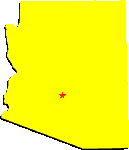
Here in Northern Arizona, we have a rainy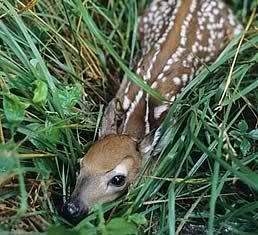 season referred to by locals as the Monsoon Season. This year and last, it began about the first week of July and lasted until the end of July. Just coincidentally, this is the time when most of the fawns are born. In other areas, fawn mule deer may be expected to be born about the first week of June. I have seen several does this week, that look like they are about ready to pop, but still haven’t shed that excess weight.
season referred to by locals as the Monsoon Season. This year and last, it began about the first week of July and lasted until the end of July. Just coincidentally, this is the time when most of the fawns are born. In other areas, fawn mule deer may be expected to be born about the first week of June. I have seen several does this week, that look like they are about ready to pop, but still haven’t shed that excess weight.
When I moved to Arizona, I expected that fawns would be born much earlier – even April. This assumption was based on the, apparently, false logic that the further south you go, the earlier spring arrives. The earlier the spring, the earlier the fawning season. Now the question that might be on your mind is – wouldn’t the breeding season have to be later?
In order for fawning to occur in late July, breeding must occur in late December – early January. Because winter doesn’t get serious until that time period, mule deer don’t have much cause to congregate. Breeding doesn’t occur until bucks and does get together. During the summer and even into late fall, mule deer in this part of the world are spread as thin as the hair on top of my head.
That’s my twist on when fawns are born and why. Pay attention and see what you observe.

The state of Utah is located in the heart of the best Mule Deer habitat on earth. Additionally, a high percentage of Utah land is public. Nevertheless, Utah may have the worst mule deer management of any state that has mule deer. Utah is one state that has capped the number of mule deer at a number substantially below carrying capacity. The DWR refers to this limitation as the “political carrying capacity”. Winter depredation claims against the DWR in the late 80’s and early 90’s were a major factor in the agency placing a ceiling on mule deer numbers.
Around 1990, the state of Utah was split into regions and the regions were split into units. At that time, Utah also implemented a lottery for obtaining deer tags. Mule deer tags, which had previously been unlimited and over-the-counter, were, and are now sold via this lottery. At the same time, the number of hunters was cut by half and a cap on the number of hunters was set at 97,000. No more than 10% of the tags for a region/unit can be awarded to non-residents. In spite of this fact, odds of a non-resident drawing a tag are, in some cases, better than for a resident.
The Utah drawing process begins in January each year, so pay attention. Utah is divided into 5 regions and 80, or so, units. The Division of Wildlife Resources (DWR) allocates tags in such a way as to distribute the greatest number of hunters where there are the least number of mule deer. That’s handy.
Even though there are a few whitetail in the Northern part of Utah, there are no tags specifically for whitetail. I suppose you could kill a whitetail on a mule deer tag, if you chose to, and if you could find one.
 In the last 25 years, Utah’s elk herd has mushroomed. This phenomenon has coincided with the decline of mule deer populations, hence, there are numerous persons and groups trying to determine if there is a relationship between increasing elk and decreasing mule deer. Thirty years ago, Utah’s few elk were primarily in the North. Today, Northern Utah possibly has the least elk in the state. Overall, the elk population has increased more than 10-fold.
In the last 25 years, Utah’s elk herd has mushroomed. This phenomenon has coincided with the decline of mule deer populations, hence, there are numerous persons and groups trying to determine if there is a relationship between increasing elk and decreasing mule deer. Thirty years ago, Utah’s few elk were primarily in the North. Today, Northern Utah possibly has the least elk in the state. Overall, the elk population has increased more than 10-fold.
It is widely believed that elk have provided an alternate prey base for mountain lions and 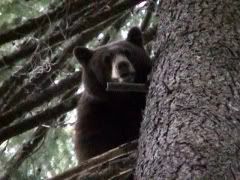 black bears, allowing predator numbers to stay at maximum while mule deer numbers remain perpetually dismal. A Utah Forest Ranger told me that, in the three year period, preceding 2003, there had been 89 black bears released between the Idaho border and the Monte Cristo highway (Rich, Cache, and Weber counties), most of which were troublesome bears removed from Yellowstone.
black bears, allowing predator numbers to stay at maximum while mule deer numbers remain perpetually dismal. A Utah Forest Ranger told me that, in the three year period, preceding 2003, there had been 89 black bears released between the Idaho border and the Monte Cristo highway (Rich, Cache, and Weber counties), most of which were troublesome bears removed from Yellowstone.
According to my calculations, the Utah mountain lion herd reached it’s maximum carrying capacity around 1990 and has been sustained at that level since then. Annual lion harvest is not allowed to exceed annual recruitment. It is believed that elk have played a key role in allowing mountain lions to be sustained at artificially high numbers while deer numbers are suppressed.
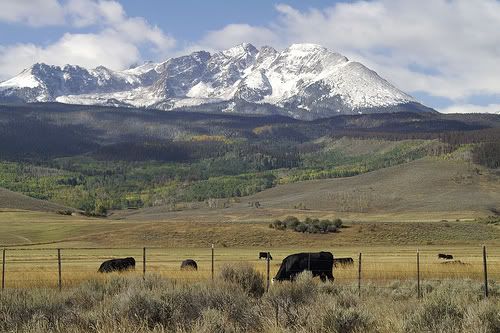 In the last twenty years, there has been a serious decline in ranching and farming in Northern Utah. This has negatively impacted mule deer both in reduced predator control and in reduced grazing which means less quality deer browse. Forest management has never been worse in terms of sustaining or creating habitat for mule deer. Forest Service personnel seem to be interested in only one type of forest – climax forest, which is not good for wildlife and which maintains a tinder box for fire. In the last two decades, southern Utah has had more favorable conditions for mule deer than Northern Utah. Moreover, Southern Utah has fewer hunters. Most of Southern Utah has remained rural. Ranching is still fairly common in Southern Utah, and predator control is still important to ranchers. There is also virtually unlimited winter habitat for most Southern Utah deer.
In the last twenty years, there has been a serious decline in ranching and farming in Northern Utah. This has negatively impacted mule deer both in reduced predator control and in reduced grazing which means less quality deer browse. Forest management has never been worse in terms of sustaining or creating habitat for mule deer. Forest Service personnel seem to be interested in only one type of forest – climax forest, which is not good for wildlife and which maintains a tinder box for fire. In the last two decades, southern Utah has had more favorable conditions for mule deer than Northern Utah. Moreover, Southern Utah has fewer hunters. Most of Southern Utah has remained rural. Ranching is still fairly common in Southern Utah, and predator control is still important to ranchers. There is also virtually unlimited winter habitat for most Southern Utah deer.
In Utah, at this time, you don’t need to worry about units unless you apply for a premium limited-entry or limited-entry unit. Otherwise, you will be applying for a region instead of a unit. The number of hunters is limited in all cases, but in the limited-entry and premium limited-entry units, the amount of real estate you can access is much more restricted than it is for a region. Premium limited-entry means there will be fewer hunters, not more deer. Limited-entry may also have few hunters, but is rated as having fewer mature bucks.
Since the inception of the lottery, the Southern region has been the most popular region, with more hunters applying for that region than the number of permits available. The Southern region also has the fewest tags available of the five regions. Some of the other regions, most notably, the Northern region, have sometimes had fewer applicants than available tags. The left-over tags are sold first-come. If you really want a tag, and missed the drawing, this is one way to get one. There have been numerous years when the Northern region did not sell out. The DWR has resorted to peddling these unwanted tags by forecasting high numbers of pre-season bucks and high success rates which is typically a pure fabrication. Don’t rely on these forecasts unless you want to have your hopes dashed.
Experienced hunters are now applying only for the premium limited-entry units and if they do not draw, they do not hunt. The premium limited-entry units are a far cry from the quality they once had, but their quality is higher than the rest, mostly because of the small number of hunters. Unfortunately, some of the tag quantities are now so low that non-residents cannot even apply. Odds of drawing a premium limited-entry tag are low, and now you must by a license before even applying for a bonus point. One problem with the bonus point scenario is that you wait years to draw, and by the time you draw things have changed, so pay attention.
I don’t know how you got here, 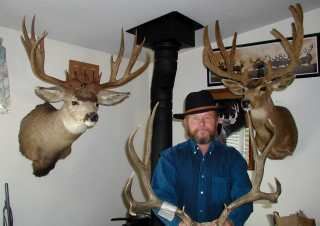 but I’m glad you came for a visit. If you have an interest in MULE DEER, you came to the right place. And we’re only just getting started. This website will continue to get better.
but I’m glad you came for a visit. If you have an interest in MULE DEER, you came to the right place. And we’re only just getting started. This website will continue to get better.
Look around. Give us some feedback. Let us know what you think. See that little blue bar at the top? You should be able to find what you’re looking for up there. Over in the left sidebar is a search box. If there’s something specific you are looking for, give it a whirl.
If there is anything about MULE DEER, we are interested in providing it or in sharing it with you. This site is all about MULE DEER with a little variety thrown in for good measure. As my mother used to say, “variety is the spice of life.” We have a lot of MULE DEER variety. You might say, we are not very wide, but we are deep.
You may not be impressed to know something about me, but if you care to know, click that little tab at the top that says “About”. I am a DIY MULE DEER guy. I Never have used a guide, though they are great for many. Never have slept in a motel for hunting. I’ve been in all kinds of places…. and seen many, many huge bucks…. a lot got away but we have killed a few. I consider myself a MULE DEER FANATIC. How about you?
Take the quiz and find out how you measure up. If you score high enough, you just might win a nice prize. The quiz will be here soon, as soon as I can figure out how to administer it. Keep in touch.
Register, participate, and enjoy. We’re glad you’re here.
Every year, while I’m hunting, I have experiences which remind me of something I had already learned, but forgotten. This year was no exception. When you are still hunting, it is a good tactic and habit to look behind you on a regular basis. I don’t know about you, but once in a while, I just get a premonition to look behind me. On one such occasion, I had been sneaking down a ridge with deer on both sides of me, hoping to get past them all without being detected so I could slip quietly out onto some ledges and shoot at the bucks bedded below them. After a successful sneak, I peered down at two bucks, but they weren’t the ones I was expecting. Without any identifiable reason, I turned around and glanced behind me. There, on the skyline, in a spot where I had been standing only a few moments before, was a large male cougar. I put the binos on him. I could practically count his whiskers. Those eyes were riveted on me and yet staring right through me. There was no doubt about where they were focused. For about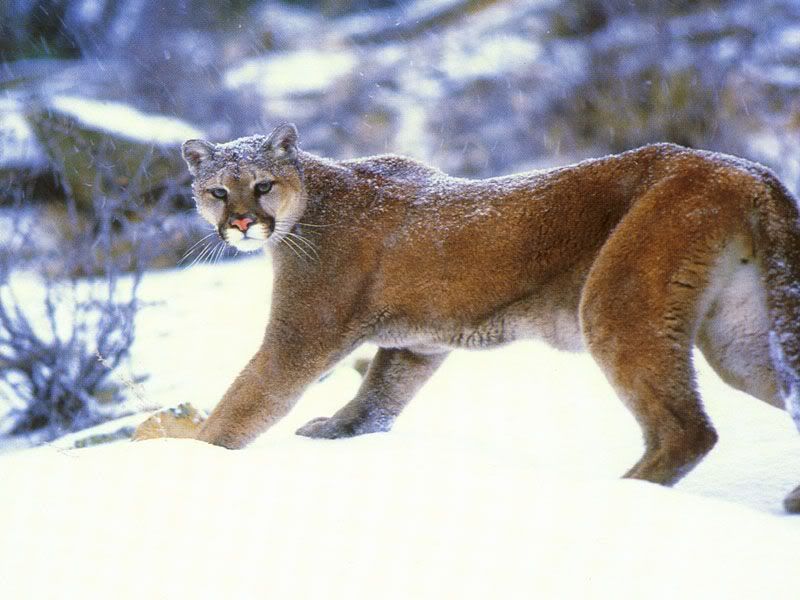 five minutes he watched me. I began to get uneasy. I clocked him at 123 yards and calculated that he could be on me in about 3 seconds. I knew he could smell me and see me, and it didn’t seem to bother him. One of the bucks spooked and ran up towards the cat, during which time, the lion continued to stare at me rather than at the buck. Apparently, the buck spotted or smelled the cat, and subsequently ran for about 3/4 mile uphill without stopping. Shortly afterwards, the cat disappeared without a sound. Because of this tactic and for my effort – I did get him on video tape.
five minutes he watched me. I began to get uneasy. I clocked him at 123 yards and calculated that he could be on me in about 3 seconds. I knew he could smell me and see me, and it didn’t seem to bother him. One of the bucks spooked and ran up towards the cat, during which time, the lion continued to stare at me rather than at the buck. Apparently, the buck spotted or smelled the cat, and subsequently ran for about 3/4 mile uphill without stopping. Shortly afterwards, the cat disappeared without a sound. Because of this tactic and for my effort – I did get him on video tape.
On another note regarding this same topic, last year while bowhunting in Southern Utah, I was cruising around on the ATV when I got this peculiar notion to look behind me. To my surprise, a very large buck was watching me drive by from his bed. I had already driven past him and I wondered how often he had successfully used that tactic – since he was obviously old and, by inference, wise. Because I looked back, I was able to video tape this buck for about 3 minutes. I estimated him to be about 3 feet in width. Had I been armed and legal, I believe I could have ended his long and successful career of evading hunters. I would guess that buck to be at least 7 years old. As it was, I was able to put my hunting parters onto him, though they did not kill him. I am working on a DVD called Amateur Velvet. If you are lucky you’ll get to see this muley buck on DVD.
Kirt Darner reportedly used a technique he called the J-hook tactic which is akin to looking behind you. Mule deer often have a habit of circling around you ( especially in heavy cover ) and returning to their original location which is where they wanted to be in the first place – until you interrupted. To use this technique, you walk back over ground you’ve already covered and then hook to the left or right – wherever you think the deer might be circling.
As hunters, especially as bowhunters, we get fairly focused on what is ahead of us and sometimes to the side of us. It can be interesting how much is going on behind us. Do you know what indian britches are? They are the kind that sneak up on your behind. Keep eyes in the back of your head and don’t let anything sneak up on your behind.
Good luck.
CLICK: MULE DEER RECORDS
CLICK: SCORING A TYPICAL BUCK
CLICK: SCORING A NON TYPICAL BUCK
Minimum Scores:
Category Awards All Time
Typical 180 190
Non-typical 215 230
———————————
Boone and Crocket Specific Guidelines:
ALTERED TROPHIES
Trophies that have been tampered with to gain an advantage obviously are not eligible for entry into the records books. Examples of trophy tampering include the deliberate removal of abnormal points from typical racks to increase a trophy’s score and/or the addition of antler or horn material. If any points are deliberately removed from antlers of any trophy by breaking or sawing them off, that trophy is not eligible for entry in the Awards Programs and/or records books. Deliberate modification of horns by adding to horn length or artificially increasing circumference measurements is also grounds for disqualification of a trophy.
DAMAGED AND/OR REPAIRED TROPHIES
Prior to January 1, 1980, the Club did not accept any repaired trophies for the records books. After that date, however, the Records Committee agreed to accept repaired trophies for the records books on a case by case basis. Trophies that have been repaired can be accepted by the Records Committee if the owner or the Official Measurer identifies the repair, and if the repair is made with original horn or antler material. The Committee still reserves the right to reject any repaired trophy, at the Committee’s discretion.
When scoring any trophies that have been repaired, no portion of the repaired material can be included in any measurement nor can any allowance be made for lost material. For example, measurements of repaired points or main beams can only be taken to the point of the break.
When measuring horns, no allowances can be made for missing horn material. For example, there are frequently large chunks of horn material missing in the area where the D-2 circumferences are taken on desert sheep. This damage probably occurs when sheep are sparring with each other. If a D-2 circumference falls on the damaged area, the circumference is still taken through the damaged area by wrapping the tape snugly around the horn.
Cat and bear skulls are also prone to being damaged. Some damage occurs naturally when bears are sparring with each other. More frequently, however, skulls are damaged when trophies are shot in the head. In any event, measurement of damaged skulls must include only the intact, unrepaired portions of the skull.
Older deer racks often have a varnish coating. It seems that varnishing trophies must have been a common practice in the “good old days,” since it seems it is generally only older racks that surface with varnish on them. Because all velvet must be removed from antlers before they can be measured, people may assume all varnish must be removed from antlers before they can be officially measured. This is not so. Basically, the antlers can be scored, so long as the varnish doesn’t have any effect on the final score. However, if there are pockets or spots of thick varnish that affect any measurements, the varnish must be removed before the trophy can be officially measured.
DRYING PERIOD
Official measurements cannot be taken until the antlers, horns, skulls or tusks have air dried at normal room temperature for least 60 days after the animal was killed. If the trophy has been frozen prior to cleaning, as is often the case with skulls, the 60-day drying period begins once the cleaning process is complete. The drying process for trophies that have been boiled or freeze-dried starts the day they are removed from the boiling pot or freeze-drier, respectively.
In the case of picked up trophies, the 60-day drying period also applies. If it is clear from the condition of the antlers, horns, skulls or tusks that the trophy has dried for more than 60 days, one does not have to wait another 60 days from when it was found to measure it. However, it is necessary to enter the approximate date the animal died on the line provided for the date of kill on the score chart. Trophy owners may be asked to provide a brief history for “picked up” trophies or trophies of unknown origin to substantiate the approximate date of death.
ENTRY DISQUALIFICATION
As keeper of the Records of North American Big Game, the Club has the inherent responsibility to maintain the integrity of the records. On occasion the validity of some entries is questioned. The Records Committee treats such questions as serious matters. If, upon completion of the Club’s investigation, it is found that the trophy was inappropriately entered, the matter is taken to the Records Committee. The typical action by the committee in such cases is to remove that trophy and all others that that particular trophy owner has entered into the records books and to preclude any future entries from that hunter or trophy owner, as the case may be.
HORN PREPARATION
Shrinkage of horns (pronghorns, goats, etc.) has been a concern of many trophy owners over the years. It is acceptable to remove horns from the skull, clean them, and then have them reset with a bonding substance as long as the horns are not altered in the process. Thus, a bonding substance can be used but its presence cannot enhance the horn’s basal circumference. Alteration of the basal circumference is grounds for disqualification of the trophy.
LOCATION OF KILL
Every effort is made by the Club to ensure that the location of kill data for trophies listed in the records books and Fair Chase magazine are accurate and correct. Space is provided on both the score chart and the Hunter, Guide and Hunt Information form to include this data for each entry.
Please keep in mind that we are looking for the following information when completing the blanks provided for the location of kill information. For trophies taken in the lower 48 states, we need the county and state (e.g. Lawrence Co., PA) where the trophy was taken (or found). If the county is unknown, we need to know the state where it was taken. A standard road atlas is used to ensure the correct spelling of counties in the lower 48 states.
For trophies taken in Canada and Alaska, we need the name of the nearest geographic feature (e.g. Post River, AK; Glacier Lake, BC; Cataract Creek, AB) that can be found on a map or in a geographic atlas of place names for that state or province. The Club has a small library of geographic atlases and topographic maps used to ensure that the name of a geographic location is a nationally accepted name (not simply a local name) and that it is properly spelled.
At times we have problems collecting geographic information from Canadian and Alaskan hunters. For example, a whitetail buck taken in an agricultural area in the prairie provinces may be a hundred miles from the nearest geographic feature. However, while we shy away from using the names of towns, since most animals are not actually killed in a town—only near it, we will use towns if no other location of kill information is available.
If there is more than one geographic feature that could be listed for a trophy, we prefer to list the feature closest to the site of kill. For example, Divide Lake is a better location of kill for a mountain caribou than the Mackenzie Mountains that covers thousands of square miles. Similarly, it is not very useful to list a location of kill for a whitetail deer as Lake Winnipeg since it stretches for hundreds of miles through the heart of Manitoba. For trophies taken in Mexico we simply need to know the state it was taken in.
If the location of kill or find is not known, the location should be listed as “unknown.” Of course, an unknown location of kill is unacceptable for trophies separated from subspecies by boundaries. For example, an elk trophy from Washington State cannot be accepted in the Roosevelt’s elk category with an unknown location of kill since we must be able to verify that it came from an area where Roosevelt’s elk are located.
It is rare that we ask an individual to pinpoint the exact location of kill for his or her trophy on a map. However, we may need this information for categories of big game separated by boundaries. If we receive this information from a trophy owner, the information remains confidential and is never divulged to anyone for any reason.
When completing the location of kill information on the score chart and HGH form please be as accurate as possible. This will continue to add scientific validity to the records listings and ensure that the location is correctly spelled.
METHOD OF HARVEST
The Boone and Crockett Club, because it recognizes the trophy and not the hunter or owner, accepts hunter-taken trophies harvested with: firearms, including muzzle loaders, pistols, shotguns, etc.; archery tackle, including compound bows and traditional archery equipment; crossbows; etc. All hunter-taken trophies are eligible for entry into the Club’s Awards Programs and records books, so long as the equipment is legal in the state or province where the animal is harvested. (Pope and Young Club only accepts trophies taken with a bow.)
The Boone and Crockett Club, because it recognizes the trophy and not the hunter or owner, also accepts trophies that are picked up (e.g. winter kills, road kills, etc.) and trophies of unknown origin (e.g. garage sales, taxidermists, attics, etc.). Trophies accepted with unknown locations of harvest are eligible only if they are for a category without a boundary.
SHED ANTLERS/SPLIT SKULLS
Shed antlers, as well as any set of antlers with a split skull plate, are not eligible for entry in the Club’s Awards Programs and/or records books, regardless of how well they have been restored to their original condition. This is because the inside spread, which is an integral part of the final score of antlered trophies, cannot be accurately determined if the skull plate is absent or split. If an official measurer suspects that a set of antlers he or she is measuring is either shed antlers or a split skull, he or she should contact the Club’s headquarters for instructions on x-raying that trophy. This policy applies to trophy specimens of deer, caribou, moose and elk, as well as pronghorn.
TROPHIES TAKEN ON RESERVATIONS
Trophies taken on tribal/communal lands in line with sound game management practices, taken in full compliance with tribal/communal laws or regulations regarding such hunting, and with possession of the usual state/provincial hunting license where applicable, and taken in full compliance with the Boone and Crockett Club’s rules of Fair Chase, will be fully accepted as entries for both awards and publication in the records books.
VELVET ANTLERS
The Boone and Crockett Club does not accept antlers in “velvet” for entry into the Awards Programs and/or records books unless the velvet is removed before official measurements are made. Remnants of velvet are permissible as long as they do not affect any measurements.
World record Typical Pope and Young Mule Deer
World record Non-typical Pope and Young Mule Deer
Pope and Young Minimum Scores
| *Mule Deer, Typical |
145 |
| *Mule Deer, Non-Typical |
170 |
What is the point in being a Mule Deer Fanatic?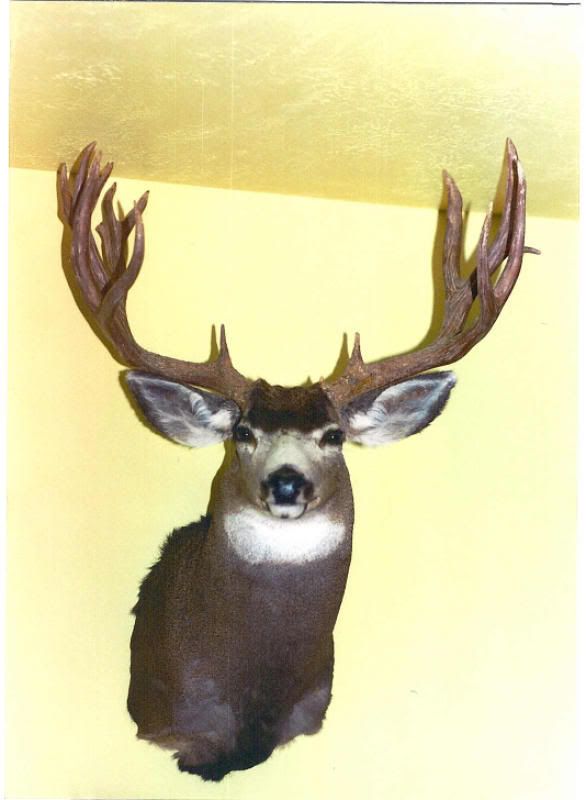
It’s always nice to see mule deer, especially a large buck. You can always enjoy stalking a buck. Photographing mule deer is also very enjoyable. Reading about mule deer is exciting. Hunting mule deer, if you can draw a tag, is getting right up there. Ultimately, though, a mule deer fanatic wants to harvest a trophy buck. If one is fortunate enough to have several trophies on the wall, that person really qualifies as a mule deer fanatic.
In order to frequently have the opportunity for a trophy buck, there has to be an investment ( and an incentive ). The investment may be made by purchasing expensive, high-quality, guided hunts. Alternatively, success can be achieved by a DIY hunter who simply has a lot of tenacity, desire, and knowhow. Some have been fortunate enough to have access to great mule deer hunting by owning enough of the right property.
I believe it is getting harder and harder to be consistently successful. One thing that every mule deer fanatic needs to do is exert influence, as much as possible, toward better mule deer management. One should not consider himself a true mule deer fanatic without doing all in his power to promote an abundance of mule deer.
The idea of abundance has not been a high priority for game managers. It is, in fact, scarcity that is most popular today. Game managers must cease their love affair with predators before we will ever see abundance again. Weather, habitat, human encroachment, hunting, and even poaching combined do not cause the scarcity that is caused by predation.
If you want to be classified as a mule deer fanatic, I believe you need to be like a nagging child that won’t go away – when it comes to voicing your wishes to those that are in control. Interestingly, individual game biologists are not in control, even though you should certainly talk to them. Even heads of departments are not that influential. None of them is elected. You really need to go after state Governors and legislators, who are elected. However, if you want to get to the top, then talk to the US Fish and Wildlife Service, or more importantly the Mule Deer Working Group. I believe this group has become the major factor in keeping scarcity in place. They would much rather fund a study to prove that predators don’t have a negative impact on deer, than to fund serious predator control – the former accomplishing nothing and the latter benefitting mankind.
Here is a link to this group. 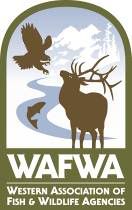 I wish that all mule deer fanatics, everywhere, would overwhelm this group with a common cause – mule deer abundance. Read their conservation plan and you will realize that “conserve” means to feed predators and reduce hunting. If you don’t like that too well – then do something about it. Send an email to every person in the group and let them know that abundance will not be achieved until predators are controlled, and that when mule deer are once again abundant, then we will consider feeding the predators. Show that you are a dyed-in-the-wool, true-blue MULE DEER FANATIC.
I wish that all mule deer fanatics, everywhere, would overwhelm this group with a common cause – mule deer abundance. Read their conservation plan and you will realize that “conserve” means to feed predators and reduce hunting. If you don’t like that too well – then do something about it. Send an email to every person in the group and let them know that abundance will not be achieved until predators are controlled, and that when mule deer are once again abundant, then we will consider feeding the predators. Show that you are a dyed-in-the-wool, true-blue MULE DEER FANATIC.